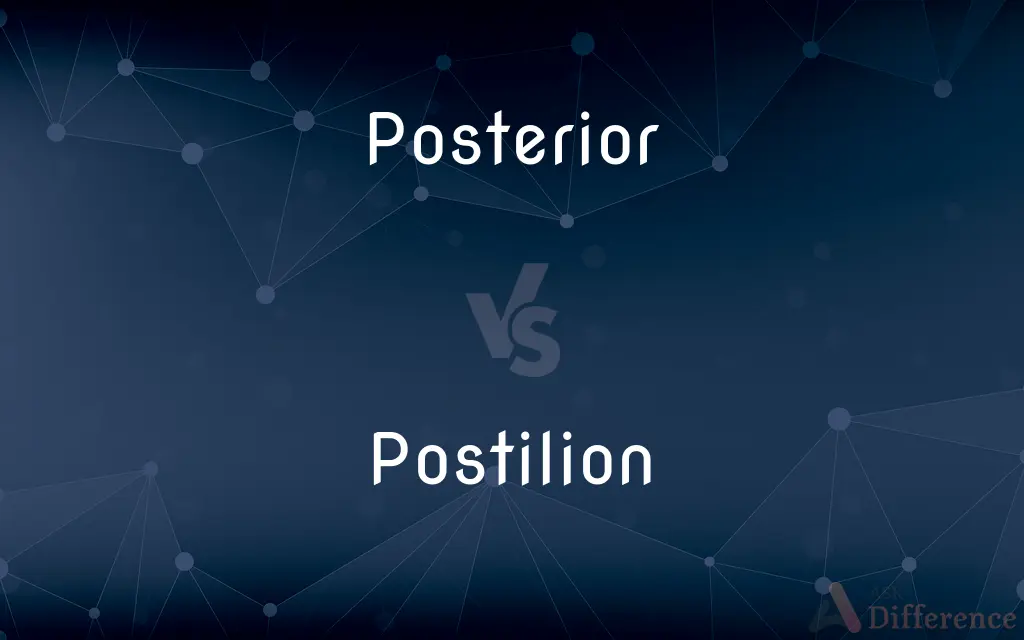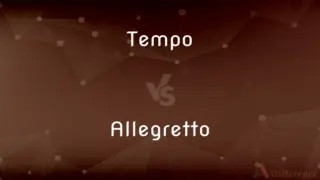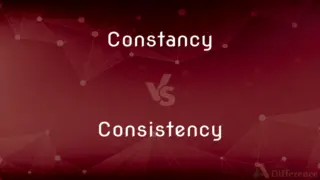Posterior vs. Postilion — What's the Difference?
By Fiza Rafique & Urooj Arif — Updated on March 20, 2024
Posterior refers to the back or rear position, often used anatomically; postilion is a person who rides the left horse of the leading pair of a team, guiding the others.

Difference Between Posterior and Postilion
Table of Contents
ADVERTISEMENT
Key Differences
The term "posterior" is predominantly used to describe something located towards the back or at the rear end. In anatomy, it specifically refers to the back side of the human body or the rear part of an individual organ or structure. This usage underscores a spatial orientation within various contexts, highlighting a position relative to other parts. Whereas, a "postilion" refers to a specific role or job in the context of horse-drawn carriages. A postilion rides the left horse of the leading or sometimes the only pair in a team, holding the reins and thus guiding the other horses. This term delves into historical transportation methods, emphasizing a human role in managing and directing horses.
While the posterior is a term broadly applicable in various fields, including anatomy, biology, and general description of objects, highlighting a particular spatial relationship, the postilion holds a niche significance. The role of a postilion is steeped in historical and cultural contexts, associated with horse-drawn carriages' operation before the advent of motorized vehicles. On the other hand, the concept of the posterior is universally applicable across disciplines to indicate a rearward location.
The significance of understanding "posterior" lies in its widespread applicability for describing positions and orientations, especially in medical and biological sciences. It helps in the precise description of body parts, their functions, and their relative positions. In contrast, understanding a "postilion" offers insights into historical practices of transportation and the evolution of human roles in facilitating movement. This role is not only historical but also ceremonial, as postilions are still used in certain traditional or ceremonial settings.
The differentiation between posterior and postilion underscores the distinction between a general descriptive term and a specific occupational role. The posterior is a foundational concept in anatomical studies, essential for learners across multiple disciplines to grasp spatial relationships within organisms. Meanwhile, the postilion represents a specialized knowledge area, reflecting historical modes of transportation and the human-animal interaction dynamics essential for those interested in history or equestrian practices.
Comparison Chart
Definition
Refers to the back or rear position
A rider of the left horse of the leading pair, guiding others
ADVERTISEMENT
Context
Widely used in anatomy, biology, and general descriptions
Specific to horse-drawn carriages and historical transportation
Significance
Indicates spatial orientation and position
Highlights a specific role in managing horse-drawn carriages
Applicability
Universal across various fields for indicating rear positions
Niche, related to equestrian practices and historical transport
Related Disciplines
Medicine, biology, anatomy
History, cultural studies, equestrianism
Compare with Definitions
Posterior
Used to describe the backside of objects or locations.
The posterior section of the building was quiet and dark.
Postilion
Requires expertise in horse handling and carriage driving.
A skilled postilion is essential for the smooth operation of horse-drawn processions.
Posterior
Anatomically referring to the rear position of a structure.
The heart is posterior to the sternum.
Postilion
Can sometimes refer to the position where one would ride without a coach.
Riding postilion style was common before the widespread use of coaches.
Posterior
Located at the back or rear.
The posterior part of the human body includes the back and buttocks.
Postilion
Historically, a necessary role for controlling horse-drawn carriages.
The postilion skillfully navigated the carriage through narrow streets.
Posterior
In biological taxonomy, referring to parts towards the organism's back.
The posterior fins of a fish are near its tail.
Postilion
Often employed in ceremonial or historical reenactments.
The postilion’s role is celebrated in annual historical parades.
Posterior
Opposite of anterior, which means towards the front.
The spinal cord is located on the posterior side of the body.
Postilion
A rider who guides the left horse of the leading pair of a team.
In traditional ceremonies, the postilion wore a distinctive uniform.
Posterior
Located behind a part or toward the rear of a structure.
Postilion
A postilion or postillion is a person who guides a horse-drawn coach or post chaise while mounted on the horse or one of a pair of horses. By contrast, a coachman controls the horses from the vehicle itself.
Posterior
Relating to the caudal end of the body in quadrupeds or the back of the body in humans and other primates.
Postilion
One who rides the near horse of the leaders to guide the horses drawing a coach.
Posterior
(Botany) Next to or facing the main stem or axis.
Postilion
A rider mounted on the near (left) leading horse who guides the team pulling a carriage.
Posterior
Coming after in order; following.
Postilion
(obsolete) A post-boy, a messenger boy, a swift letter carrier.
Posterior
Following in time; subsequent.
Postilion
One who rides and guides the first pair of horses of a coach or post chaise; also, one who rides one of the horses when one pair only is used.
Posterior
The buttocks.
Postilion
Someone who rides the near horse of a pair in order to guide the horses pulling a carriage (especially a carriage without a coachman)
Posterior
(anatomy) Nearer the rear or hind end; nearer the caudal end of the body in quadrupeds or the dorsal end in bipeds.
Posterior
(medicine) Relating to or denoting presentation of a fetus in which the rear or caudal end is nearest the cervix and emerges first at birth.
Posterior
(botany) Next to, or facing the main stem or axis.
Posterior
(formal) Following in order or in time.
Posterior
The hinder parts of the body.
Posterior
(maths) The probability that a hypothesis is true (calculated by Bayes' theorem).
Posterior
Later in time; hence, later in the order of proceeding or moving; coming after; - opposed to prior.
Hesiod was posterior to Homer.
Posterior
Situated behind; hinder; - opposed to anterior.
Posterior
At or toward the caudal extremity; caudal; - in human anatomy often used for dorsal.
Posterior
On the side next the axis of inflorescence; - said of an axillary flower.
Posterior
The fleshy part of the human body that you sit on;
He deserves a good kick in the butt
Are you going to sit on your fanny and do nothing?
Posterior
A tooth situated at the back of the mouth
Posterior
At or near the hind end in quadrupeds or toward the spine in primates
Common Curiosities
Can "posterior" be used outside of medical contexts?
Yes, posterior can describe the rear position of any object or concept, not just in medical or anatomical contexts.
Is the role of a postilion still relevant today?
While largely ceremonial or historical, the role of a postilion persists in certain traditional settings and reenactments.
Are there modern equivalents to postilions?
In modern contexts, the closest equivalents might be drivers or operators of vehicles, though the direct role of postilion has no direct modern counterpart.
What historical significance does a postilion have?
Postilions were crucial for the operation of horse-drawn carriages, reflecting historical transportation methods before motorized vehicles.
How does one become a postilion?
Traditionally, becoming a postilion involved training in equestrian skills and learning specific techniques for driving horse-drawn carriages.
Can the term "posterior" apply to inanimate objects?
Yes, posterior can describe the rear position of inanimate objects, such as parts of buildings or vehicles.
Is there a specific attire for a postilion?
Historically, postilions often wore distinctive uniforms or attire, which could vary depending on the region and era.
Who is a postilion?
A postilion is a person who rides the left horse of the leading pair in a horse-drawn carriage, guiding the other horses.
How is the term "posterior" important in anatomy?
In anatomy, posterior is a directional term used to describe the location of body parts in relation to each other.
What skills are required to be a postilion?
Being a postilion requires expertise in horse riding and handling, as well as knowledge of carriage driving.
What does "posterior" mean?
Posterior refers to a position at the back or rear, especially in anatomical contexts.
What does it mean when something is described as being in the posterior position?
It means that the object or part is situated towards the back or rear relative to other parts or directions.
What's the difference between anterior and posterior?
Anterior refers to the front position, while posterior refers to the back or rear position.
How do posterior positions affect medical treatments or diagnoses?
Understanding posterior positions is crucial in medical fields for accurate diagnoses, treatment plans, and surgical procedures, as it helps in precisely locating and addressing issues within the body.
Why might someone use a postilion in modern times?
Today, postilions are mainly used for ceremonial purposes, historical reenactments, or as a part of traditional events.
Share Your Discovery

Previous Comparison
Tempo vs. Allegretto
Next Comparison
Constancy vs. ConsistencyAuthor Spotlight
Written by
Fiza RafiqueFiza Rafique is a skilled content writer at AskDifference.com, where she meticulously refines and enhances written pieces. Drawing from her vast editorial expertise, Fiza ensures clarity, accuracy, and precision in every article. Passionate about language, she continually seeks to elevate the quality of content for readers worldwide.
Co-written by
Urooj ArifUrooj is a skilled content writer at Ask Difference, known for her exceptional ability to simplify complex topics into engaging and informative content. With a passion for research and a flair for clear, concise writing, she consistently delivers articles that resonate with our diverse audience.














































